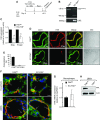Conditional deletion of FAK in mice endothelium disrupts lung vascular barrier function due to destabilization of RhoA and Rac1 activities
- PMID: 23771883
- PMCID: PMC3891015
- DOI: 10.1152/ajplung.00094.2013
Conditional deletion of FAK in mice endothelium disrupts lung vascular barrier function due to destabilization of RhoA and Rac1 activities
Abstract
Loss of lung-fluid homeostasis is the hallmark of acute lung injury (ALI). Association of catenins and actin cytoskeleton with vascular endothelial (VE)-cadherin is generally considered the main mechanism for stabilizing adherens junctions (AJs), thereby preventing disruption of lung vascular barrier function. The present study identifies endothelial focal adhesion kinase (FAK), a nonreceptor tyrosine kinase that canonically regulates focal adhesion turnover, as a novel AJ-stabilizing mechanism. In wild-type mice, induction of ALI by intraperitoneal administration of lipopolysaccharide or cecal ligation and puncture markedly decreased FAK expression in lungs. Using a mouse model in which FAK was conditionally deleted only in endothelial cells (ECs), we show that loss of EC-FAK mimicked key features of ALI (diffuse lung hemorrhage, increased transvascular albumin influx, edema, and neutrophil accumulation in the lung). EC-FAK deletion disrupted AJs due to impairment of the fine balance between the activities of RhoA and Rac1 GTPases. Deletion of EC-FAK facilitated RhoA's interaction with p115-RhoA guanine exchange factor, leading to activation of RhoA. Activated RhoA antagonized Rac1 activity, destabilizing AJs. Inhibition of Rho kinase, a downstream effector of RhoA, reinstated normal endothelial barrier function in FAK-/- ECs and lung vascular integrity in EC-FAK-/- mice. Our findings demonstrate that EC-FAK plays an essential role in maintaining AJs and thereby lung vascular barrier function by establishing the normal balance between RhoA and Rac1 activities.
Keywords: acute lung injury; adherens junctions; endothelial barrier; focal adhesion kinase.
Figures






Similar articles
-
Cigarette smoke causes lung vascular barrier dysfunction via oxidative stress-mediated inhibition of RhoA and focal adhesion kinase.Am J Physiol Lung Cell Mol Physiol. 2011 Dec;301(6):L847-57. doi: 10.1152/ajplung.00178.2011. Epub 2011 Oct 7. Am J Physiol Lung Cell Mol Physiol. 2011. PMID: 21984567 Free PMC article.
-
N-cadherin signaling via Trio assembles adherens junctions to restrict endothelial permeability.J Cell Biol. 2019 Jan 7;218(1):299-316. doi: 10.1083/jcb.201802076. Epub 2018 Nov 21. J Cell Biol. 2019. PMID: 30463880 Free PMC article.
-
SH2 domain-containing protein tyrosine phosphatase 2 and focal adhesion kinase protein interactions regulate pulmonary endothelium barrier function.Am J Respir Cell Mol Biol. 2015 Jun;52(6):695-707. doi: 10.1165/rcmb.2013-0489OC. Am J Respir Cell Mol Biol. 2015. PMID: 25317600 Free PMC article.
-
Driving Rho GTPase activity in endothelial cells regulates barrier integrity.Thromb Haemost. 2010 Jan;103(1):40-55. doi: 10.1160/TH09-06-0403. Epub 2009 Sep 30. Thromb Haemost. 2010. PMID: 20062930 Review.
-
Cross talk between focal adhesion kinase and cadherins: role in regulating endothelial barrier function.Microvasc Res. 2012 Jan;83(1):3-11. doi: 10.1016/j.mvr.2011.08.001. Epub 2011 Aug 16. Microvasc Res. 2012. PMID: 21864544 Free PMC article. Review.
Cited by
-
Suppression of Endothelial Cell FAK Expression Reduces Pancreatic Ductal Adenocarcinoma Metastasis after Gemcitabine Treatment.Cancer Res. 2022 May 16;82(10):1909-1925. doi: 10.1158/0008-5472.CAN-20-3807. Cancer Res. 2022. PMID: 35350066 Free PMC article.
-
TIMP1 preserves the blood-brain barrier through interacting with CD63/integrin β 1 complex and regulating downstream FAK/RhoA signaling.Acta Pharm Sin B. 2020 Jun;10(6):987-1003. doi: 10.1016/j.apsb.2020.02.015. Epub 2020 Mar 5. Acta Pharm Sin B. 2020. PMID: 32642407 Free PMC article.
-
A critical review of the American Journal of Physiology-Lung Cellular and Molecular Physiology: 2012-2015.Am J Physiol Lung Cell Mol Physiol. 2014 Dec 15;307(12):L911-6. doi: 10.1152/ajplung.00330.2014. Epub 2014 Nov 7. Am J Physiol Lung Cell Mol Physiol. 2014. PMID: 25381028 Free PMC article. Review.
-
Antitumor effect of focal adhesion kinase inhibitor PF562271 against human osteosarcoma in vitro and in vivo.Cancer Sci. 2017 Jul;108(7):1347-1356. doi: 10.1111/cas.13256. Epub 2017 Jun 8. Cancer Sci. 2017. PMID: 28406574 Free PMC article.
-
Regulation of pulmonary endothelial barrier function by kinases.Am J Physiol Lung Cell Mol Physiol. 2016 Nov 1;311(5):L832-L845. doi: 10.1152/ajplung.00233.2016. Epub 2016 Sep 23. Am J Physiol Lung Cell Mol Physiol. 2016. PMID: 27663990 Free PMC article. Review.
References
-
- Bachmaier K, Toya S, Gao X, Triantafillou T, Garrean S, Park GY, Frey RS, Vogel S, Minshall R, Christman JW, Tiruppathi C, Malik AB. E3 ubiquitin ligase Cblb regulates the acute inflammatory response underlying lung injury. Nat Med 13: 920–926, 2007 - PubMed
-
- Carbajal JM, Schaeffer RC., Jr RhoA inactivation enhances endothelial barrier function. Am J Physiol Cell Physiol 277: C955–C964, 1999 - PubMed
Publication types
MeSH terms
Substances
Grants and funding
LinkOut - more resources
Full Text Sources
Other Literature Sources
Molecular Biology Databases
Research Materials
Miscellaneous

